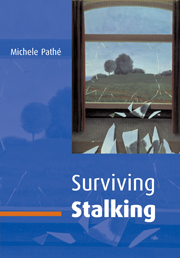Book contents
- Frontmatter
- Contents
- Acknowledgments
- Introduction
- 1 What is stalking?
- 2 How common is stalking?
- 3 Who stalks?
- 4 Could I be assaulted?
- 5 Can stalkers be treated?
- 6 Who are the victims of stalking?
- 7 The impact of stalking
- 8 Reducing your chances of victimization
- 9 Evading the stalker
- 10 Navigating the criminal justice system in the United States of America
- 11 Navigating the criminal justice system in the United Kingdom
- 12 Navigating the criminal justice system in Australia
- 13 Should I just disappear?
- 14 How do I deal with the emotional impact of stalking?
- 15 How you can assist victims of stalking
- Conclusions
- References
- Reading guide
- Appendix 1 Other resources
- Appendix 2 Protection from Harassment Act 1997
- Appendix 3 Sample restraining order under Protection from Harassment Act 1997
- Appendix 4 Criminal justice system flow chart, UK
- Index
8 - Reducing your chances of victimization
Published online by Cambridge University Press: 04 September 2009
- Frontmatter
- Contents
- Acknowledgments
- Introduction
- 1 What is stalking?
- 2 How common is stalking?
- 3 Who stalks?
- 4 Could I be assaulted?
- 5 Can stalkers be treated?
- 6 Who are the victims of stalking?
- 7 The impact of stalking
- 8 Reducing your chances of victimization
- 9 Evading the stalker
- 10 Navigating the criminal justice system in the United States of America
- 11 Navigating the criminal justice system in the United Kingdom
- 12 Navigating the criminal justice system in Australia
- 13 Should I just disappear?
- 14 How do I deal with the emotional impact of stalking?
- 15 How you can assist victims of stalking
- Conclusions
- References
- Reading guide
- Appendix 1 Other resources
- Appendix 2 Protection from Harassment Act 1997
- Appendix 3 Sample restraining order under Protection from Harassment Act 1997
- Appendix 4 Criminal justice system flow chart, UK
- Index
Summary
Clearly, the best means of escaping harm at the hands of a stalker is to avoid succumbing to his advances in the first place. Those already snarled in the stalkers' nets often ask if there is anything they could or should have done differently. While it may allay their guilt and self blame to know that in many cases little could have been done to avoid their stalkers' attentions, it doubtless offers meagre comfort to those grappling with feelings of powerlessness and teetering on the margins of an increasingly malevolent world. In fact, there are certain characteristics in any would-be suitor that signal potential to be a stalker. This chapter outlines a number of measures aimed at reducing the likelihood of ever becoming a victim of stalking, while the following chapter will provide current victims with strategies for deterring their stalkers and halting the progression to long-term harassment.
Identifying the would-be stalker
Stalkers seldom have any distinguishing features that could forewarn potential prey. Few will volunteer any criminal history, and those who do are likely to deny or minimize the seriousness of their offending. Problems in previous relationships are commonly rationalized, with the previous partner depicted as the dysfunctional party. In some instances, the stalker will continue to harass a former intimate even while embarking on another relationship.
There is generally little that can be done to prevent victimization by a stranger.
- Type
- Chapter
- Information
- Surviving Stalking , pp. 57 - 62Publisher: Cambridge University PressPrint publication year: 2002



